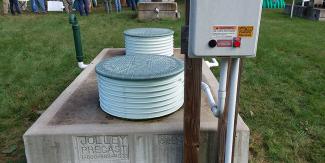Alternative & Experimental Technologies
DEM's Onsite Wastewater Treatment System (OWTS) Rules provide the basis for approval of Alternative and Experimental (A/E) Technologies in Rhode Island. A/E systems are designed as alternatives to a conventional OWTS or parts of a conventional system. A conventional system is a traditional OWTS with a septic tank, pump chamber with pump or siphon (if needed), distribution box and a standard leach field with gravity distribution. An Alternative/Experimental System or Technology is an OWTS that does not meet the location, design or construction requirements of a conventional system, but has been demonstrated through field testing, calculations and other engineering evaluations to provide the same degree (or better) of environmental and public health protection. There are three different categories of A/E technologies: alternative systems, system components, and experimental systems.
Alternative Systems
This category has two classes of certification: Class I and Class II. An A/E system that is certified as Class I has been shown to have at least four consecutive years of quality performance data which clearly demonstrate that all applicable standards have been met. A Class I system must also have been approved for at least four consecutive years in Rhode Island or at least three other jurisdictions. A Class II certification is issued to technologies that have at least two years of performance data, have demonstrated a theory or applied research, and have been approved in Rhode Island or another jurisdiction for at least two consecutive years.
System Components
This category also has two classes of certification: Class I and Class II. A system component that is certified as Class I has been shown to have at least two consecutive years of performance data and has been approved for at least two consecutive years in Rhode Island or at least three other jurisdictions. Class II certification is issued to components that provide at least one year of performance data, demonstrate a theory or applied research, have been approved for use in at least one other jurisdiction, and have performed successfully for a minimum of one year.
Experimental Systems
This category is designed to allow innovative systems that have been demonstrated to work in practice or theory to be installed on a limited basis as they are further tested and studied. Between three and ten systems must be installed on approved sites where both the property owner and subsequent purchasers agree to abandon the experimental system and install a conventional or A/E approved Class I system if the experimental system fails to perform as designed.
For a technology to be approved for use in the state of Rhode Island, the Vendor of that technology must submit an application package to the Department's Alternative/Experimental Technology Program for review. The application package is then reviewed by Department staff for completeness. Completed applications are forwarded to the Department's OWTS Technical Review Committee (TRC). The TRC is made up of members from the Department, Coastal Resource Management Council, local Universities, OWTS design and installation firms, local municipalities, and environmental organizations. The TRC reviews all A/E applications and makes recommendations to the Department based on their findings. The Department then issues the final approval or denial.
An approval is documented in the form of a Certification which is signed by the Chief of the Permitting Section in the Office of Water Resources. The Certification lists any design requirements or restrictions placed on the technology and it also indicates the general requirements and any sampling and reporting requirements associated with the technology. After a technology is certified by the Department, the Vendor must submit a Design and Installation Manual for review. When the technology's Design and Installation Manual is approved the technology is then placed on the Department's List of Approved Innovative/ Alternative Technologies. Once an Alternative/Experimental technology is on the list then individual applications to design, construct, alter, or install these technologies may be submitted to the Department. Please note that an A/E technology is not approved for use under the program until placed on the list. Individual OWTS applications submitted to the Department proposing a technology not yet listed as of the date of receipt of the application will be returned.








